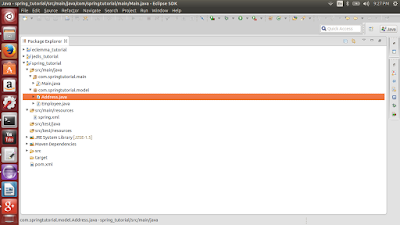In Spring
there are 5 types of scopes exist.
1. singleton – Only one instance per spring
conainer. This is the default behavior. This kind of beans initialized, when the context being
initialized.
2. prototype – Return a new bean instance
each time when requested.
3. request – New bean per each servlet
request.
4. session – Return a single bean instance
per HTTP session.
5. globalSession – Return a single bean
instance per global HTTP session.
In this
post i am going to explain about both singleton and prototype scope beans.
Singleton
Scope
Step 1
: Create new
maven project “spring_tuorial”. Project structure looks like below.
Step 2
: Update
“pom.xml” file for maven dependencies.
pom.xml
<project xmlns="http://maven.apache.org/POM/4.0.0" xmlns:xsi="http://www.w3.org/2001/XMLSchema-instance" xsi:schemaLocation="http://maven.apache.org/POM/4.0.0 http://maven.apache.org/xsd/maven-4.0.0.xsd"> <modelVersion>4.0.0</modelVersion> <groupId>spring_tutorial</groupId> <artifactId>spring_tutorial</artifactId> <version>0.0.1-SNAPSHOT</version> <packaging>war</packaging> <name>spring_tutorial</name> <description>spring_tutorial</description> <properties> <org.springframework-version>4.1.5.RELEASE</org.springframework-version> </properties> <dependencies> <dependency> <groupId>org.springframework</groupId> <artifactId>spring-context</artifactId> <version>${org.springframework-version}</version> </dependency> </dependencies> </project>
Step
3: Create new
package “com.springtutorial.model” under “src/main/java”.
Step
4: Create
“Address” class under the package “com.springtutorial.model”.
package com.springtutorial.model; public class Address { private String street; private String city; private String state; private String country; private String pin; public String getStreet() { return street; } public void setStreet(String street) { this.street = street; } public String getCity() { return city; } public void setCity(String city) { this.city = city; } public String getState() { return state; } public void setState(String state) { this.state = state; } public String getCountry() { return country; } public void setCountry(String country) { this.country = country; } public String getPin() { return pin; } public void setPin(String pin) { this.pin = pin; } @Override public String toString() { StringBuilder builder = new StringBuilder(); builder.append("Address [street=").append(street).append(", city=").append(city) .append(", state=").append(state).append(", country=").append(country).append(", pin=") .append(pin).append("]"); return builder.toString(); } }
Step
5: Create
“Employee” class under the package “com.springtutorial.model”.
package com.springtutorial.model; public class Employee { private String firstName; private String lastName; private int id; private Address address; public String getFirstName() { return firstName; } public void setFirstName(String firstName) { this.firstName = firstName; } public String getLastName() { return lastName; } public void setLastName(String lastName) { this.lastName = lastName; } public int getId() { return id; } public void setId(int id) { this.id = id; } public Address getAddress() { return address; } public void setAddress(Address address) { this.address = address; } @Override public String toString() { StringBuilder builder = new StringBuilder(); builder.append("Employee [firstName=").append(firstName).append(", lastName=").append(lastName) .append(", id=").append(id).append(", address=").append(address).append("]"); return builder.toString(); } }
Step
6: Create
“spring.xml” file in “src/main/resources”.
spring.xml
<?xml version="1.0" encoding="UTF-8"?> <beans xmlns="http://www.springframework.org/schema/beans" xmlns:xsi="http://www.w3.org/2001/XMLSchema-instance" xsi:schemaLocation="http://www.springframework.org/schema/beans http://www.springframework.org/schema/beans/spring-beans-3.0.xsd"> <bean id="employee1" class="com.springtutorial.model.Employee"> <property name="firstName" value="Hari Krishna" /> <property name="lastName" value="Gurram" /> <property name="id" value="553" /> <property name="address" ref="address" /> </bean> <bean id="address" class="com.springtutorial.model.Address"> <property name="street" value="Chowdeswari temple" /> <property name="city" value="Bangalore" /> <property name="state" value="Karnataka" /> <property name="country" value="India" /> <property name="pin" value="560037" /> </bean> </beans>
"spring.xml"
is used to assign unique IDs to different beans, to control the creation of
objects with different values. You have to make sure that “spring.xml” file is
available in CLASSPATH and use the same name in main application while creating
application context as shown in Main.java file.
Step 7
: Create package
“com.springtutorial.main” under “src/main/java”.
Step 8
: Create Main
class under package “com.springtutorial.main”.
package com.springtutorial.main; import org.springframework.context.ApplicationContext; import org.springframework.context.support.ClassPathXmlApplicationContext; import com.springtutorial.model.Employee; public class Main { public static void main(String args[]) { ApplicationContext context = new ClassPathXmlApplicationContext("spring.xml"); Employee emp1 = (Employee) context.getBean("employee1"); System.out.println(emp1); emp1.setFirstName("Kiran Kumar"); emp1.setLastName("Darsi"); Employee emp2 = (Employee) context.getBean("employee1"); System.out.println(emp2); } }
Step 9
: Run
Main.java,you will get output like below.
Mar 23, 2015 10:33:25 PM org.springframework.context.support.ClassPathXmlApplicationContext prepareRefresh INFO: Refreshing org.springframework.context.support.ClassPathXmlApplicationContext@6fa22b: startup date [Mon Mar 23 22:33:25 IST 2015]; root of context hierarchy Mar 23, 2015 10:33:25 PM org.springframework.beans.factory.xml.XmlBeanDefinitionReader loadBeanDefinitions INFO: Loading XML bean definitions from class path resource [spring.xml] Employee [firstName=Hari Krishna, lastName=Gurram, id=553, address=Address [street=Chowdeswari temple, city=Bangalore, state=Karnataka, country=India, pin=560037]] Employee [firstName=Kiran Kumar, lastName=Darsi, id=553, address=Address [street=Chowdeswari temple, city=Bangalore, state=Karnataka, country=India, pin=560037]] Mar 23, 2015 10:33:25 PM org.springframework.context.support.ClassPathXmlApplicationContext doClose INFO: Closing org.springframework.context.support.ClassPathXmlApplicationContext@6fa22b: startup date [Mon Mar 23 22:33:25 IST 2015]; root of context hierarchy
As you
observe output, “emp2” reflects the changes that are updated by emp1. It is
because, by default, the bean returned by spring is singleton.
Final
project structure looks like below.
Prototype
scope
By using
“scope” attribue we can create prototype beans.
<bean id="employee1"
class="com.springtutorial.model.Employee"
scope="prototype">
<property
name="firstName" value="Hari Krishna" />
<property
name="lastName" value="Gurram" />
<property
name="id" value="553" />
</bean>
Above
snippet makes Employee bean as prototype. New Employee instance is returned,
for every get bean request.
Update
spring.xml like below and rerun Main.java.
<?xml version="1.0" encoding="UTF-8"?> <beans xmlns="http://www.springframework.org/schema/beans" xmlns:xsi="http://www.w3.org/2001/XMLSchema-instance" xsi:schemaLocation="http://www.springframework.org/schema/beans http://www.springframework.org/schema/beans/spring-beans-3.0.xsd"> <bean id="employee1" class="com.springtutorial.model.Employee" scope="prototype"> <property name="firstName" value="Hari Krishna" /> <property name="lastName" value="Gurram" /> <property name="id" value="553" /> <property name="address" ref="address" /> </bean> <bean id="address" class="com.springtutorial.model.Address"> <property name="street" value="Chowdeswari temple" /> <property name="city" value="Bangalore" /> <property name="state" value="Karnataka" /> <property name="country" value="India" /> <property name="pin" value="560037" /> </bean> </beans>
Output
looks like below.
Mar 23, 2015 10:32:00 PM org.springframework.context.support.ClassPathXmlApplicationContext prepareRefresh INFO: Refreshing org.springframework.context.support.ClassPathXmlApplicationContext@6fa22b: startup date [Mon Mar 23 22:32:00 IST 2015]; root of context hierarchy Mar 23, 2015 10:32:00 PM org.springframework.beans.factory.xml.XmlBeanDefinitionReader loadBeanDefinitions INFO: Loading XML bean definitions from class path resource [spring.xml] Employee [firstName=Hari Krishna, lastName=Gurram, id=553, address=Address [street=Chowdeswari temple, city=Bangalore, state=Karnataka, country=India, pin=560037]] Employee [firstName=Hari Krishna, lastName=Gurram, id=553, address=Address [street=Chowdeswari temple, city=Bangalore, state=Karnataka, country=India, pin=560037]] Mar 23, 2015 10:32:00 PM org.springframework.context.support.ClassPathXmlApplicationContext doClose INFO: Closing org.springframework.context.support.ClassPathXmlApplicationContext@6fa22b: startup date [Mon Mar 23 22:32:00 IST 2015]; root of context hierarchy


No comments:
Post a Comment